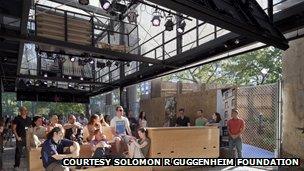New York 'urban lab' seeks to solve city-style problems
- Published
New Yorkers react to the lab which has been set up in a formerly rat-infested plot in Manhattan
With three out of five people across the globe projected to be city dwellers by 2030, transport, liveability and other urban issues are increasingly vital. Tom Brook visits a laboratory and community centre in New York City that encourages urbanites to take on these problems themselves.
On a small, once rat-infested parcel of land on the Lower East Side of New York City's Manhattan borough sits an ambitious new urban experiment.
It's called the BMW Guggenheim Lab - a small, modern-looking temporary structure that is both a think-tank and community centre, designed to identify and solve urban problems.
It comes at a time of pressing need: the world's urban population is projected to reach five billion by 2030, with three out of five people across the globe living in cities, the UN estimates.
"The aim is to be a forum for discussion of ideas about the challenges of urban living, to understand how cities work and to give us a sense of ownership to changes things and improve things if we need to," says Maria Nicanor of New York's Guggenheim Museum, who has helped develop the lab.
Bedbugs and bicycles
The lab offers the public urban-themed lectures, new technology demonstrations, film screenings as well as games designed to give insight into policy decision making in cities.
Organisers hope visitors in New York and beyond and will leave believing that cities belong to them and that they can shape their destiny.

The lab was opened in August on a site owned by the New York Parks Department
Terry Rogers, a local resident visiting the lab, explains her concerns about life in New York City.
"There's a bedbug epidemic, and that makes everybody nervous," she says. "The bicycles are the most dangerous thing for me, they do not follow the traffic laws. I have almost been hit by a bicycle many, many times."
Another visitor, Evan Vogel, is frustrated by New York's creaky public transport infrastructure.
While the lab offers no specific remedies for bedbugs or bicycles, it did present a way to think about transportation through a game called Urbanology, external.
Transport vs sustainability
In one part of the exhibit, a series of questions on urban policy flash on a large video screen, intended to goad the audience to take on the role of urban planners.
Visitors are asked, for instance, if they would provide special transport services to large companies seeking to relocate.
Answering "yes" might improve transport but could decrease liveability and sustainability.
The game provokes spirited discussion between the game leader and the players.
In mid-October, after 10 weeks in New York, the lab will move on to Berlin and then Mumbai, where organisers hope it can help identify problems in those host cities.
In Mumbai, David Van Der Leer of the Guggenheim Museum hopes to explore the lack of mobility between neighbourhoods.
"People in Mumbai cannot pay for the transportation system however cheap public transportation is, so they stick in their own neighbourhoods and other neighbourhoods are not accessible for them," he says.
'Foreign entity'
If the New York experience is anything to go by then one of the challenges facing the lab is that the indigenous population may view its arrival with suspicion.
Carl, a homeless man who did not want to give his last name, says the lab is not "in sync" with its surrounding neighbourhood.
"It's a foreign entity with new ideas being forced upon the neighbourhood," he says.
A small group of protesters staged a demonstration at the lab because they see it as a symbol of the ongoing gentrification that's been taking place in the neighbourhood, which they claim has driven out lower-income residents.
Mr Van Der Leer says the lab has provided a forum for addressing concerns over controversial issues.
"The people who came to protest, some of these people, later on came to programmes about gentrification, and realised that it could actually contribute something substantial to these conversations," he says.
When so much of city life is controlled by government and big business can the lab really do anything substantial to deal with the explosive growth in the world's urban population?
"I think the first thing in this case is raising awareness and I think that's much more important than immediately trying to get ideas executed," Mr Van Der Leer says.